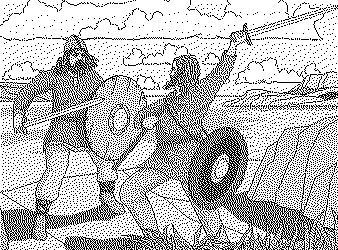 Another way to settle a dispute was by «holmgang», which was somewhat
like a duel between two individuals. The two warriors would meet, with sword and shield, and have a fight of life and death. In the Cormac's saga you can read:
Another way to settle a dispute was by «holmgang», which was somewhat
like a duel between two individuals. The two warriors would meet, with sword and shield, and have a fight of life and death. In the Cormac's saga you can read:
So the hide was taken and spread under their feet. Thorgils held his brother's shield, and Thord Arndisarson that of Bersi. Bersi struck the first blow, and cleft Cormac's shield; Cormac struck at Bersi to the like peril. Each of them cut up and spoilt three shields of the other's. Then it was Cormac's turn. He struck at Bersi, who parried with Whitting
(Bersi's sword). Skofnung (Cormac's sword) cut the point off Whitting in front of the ridge. The sword-point flew upon Cormac's hand, and he was wounded in the thumb. The joint was cleft, and blood dropped upon the hide. Thereupon folk went between them and stayed the fight.Then said Cormac, "This is a mean victory that Bersi has gained; it is only from my bad luck; and yet we must part."
He flung down his sword, and it met Bersi's target. A shard was broken out of Skofnung, and fire flew out of Thorveig's gift. Bersi asked the money for release, Cormac said it would be paid; and so they parted."
In the 800’s there were approx. 30 small chieftain-doms or kingdoms in Norway. As the population increased these societies had more contact with each other. Soon they needed common rules about the rights to fishing, grazing, hunting, and human rights as well. Also, during the Iron Age and the Viking Period trade became more important. People needed to devise bigger, more encompassing Thing districts than the older, smaller local Things.
The oldest example we know about was in Trøndelag. Through the 600-700’s the people living at the Throndhjemfjord had so much interaction that they organized the area into 8 counties. Each county had their own Thing and linking them together was an Øre-Thing which covered all 8 counties. It’s from this era that we believe the Thing-system, as we know it from the sagas, achieved its classical form in Norway.